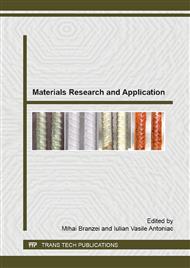p.3
p.9
p.13
p.22
p.29
p.38
p.44
p.50
Microstructural Refinement in a Commercial Aluminum Alloy Processed by ECAP Using a Die Channel Angle of 110 Degrees
Abstract:
The properties of ultra-fine grained materials are superior to those of corresponding conventional coarse grained materials, being significantly improved as a result of grain refinement. Equal channel angular pressing (ECAP) is an efficient method for modifying the microstructure by refining grain size via severe plastic deformation (SPD) in producing ultra-fine grained materials (UFG) and nanomaterials (NM). The grain sizes produced by ECAP processing are typically in the submicrometer range and this leads to high strength at ambient temperatures. ECAP is performed by pressing test samples through a die containing two channels, equal in cross-section and intersecting at a certain angle. The billet experiences simple shear deformation at the intersection, without any precipitous change in the cross-section area because the die prevents lateral expansion and therefore the billet can be pressed more than once and it can be rotated around its pressing axis during subsequent passes. After ECAP significant grain refinement occurs together with dislocation strengthening, resulting in a considerable enhancement in the strength of the alloys. A commercial AlMgSi alloy (AA6063) was investigated in this study. The specimens were processed for a number of passes up to nine, using a die channel angle of 110°, applying the ECAP route BC. After ECAP, samples were cut from each specimen and prepared for metallographic analysis. The microstructure of the ECAP-ed and as-received material was investigated using optical (OLYMPUS – BX60M) and SEM microscopy (TESCAN VEGA II – XMU). It was determined that for the as-received material the microstructure shows a rough appearance, with large grains of dendritic or seaweed aspect and with a secondary phase at grain boundaries (continuous casting structure). For the ECAP processed samples, the microstructure shows a finished aspect, with refined, elongated grains, also with crumbled and uniformly distributed second phase particles after a typical ECAP texture.
Info:
Periodical:
Pages:
3-8
Citation:
Online since:
July 2015
Authors:
Price:
Сopyright:
© 2015 Trans Tech Publications Ltd. All Rights Reserved
Share:
Citation:


